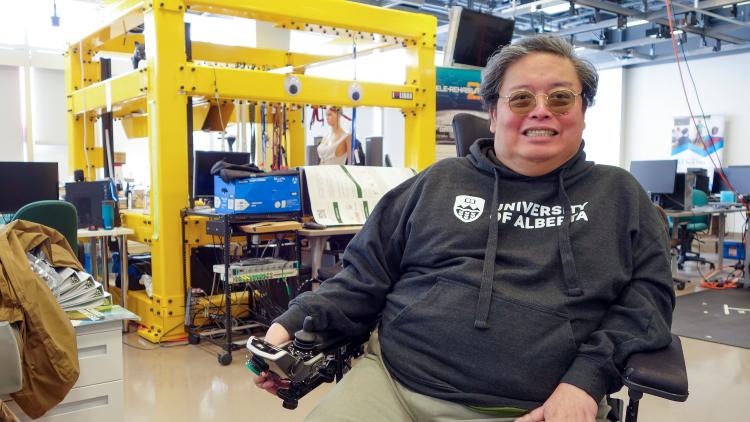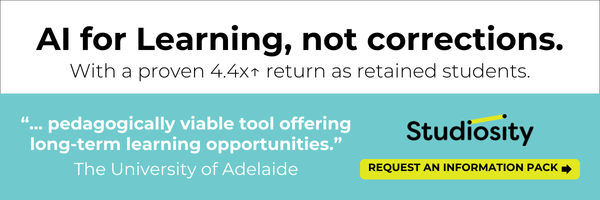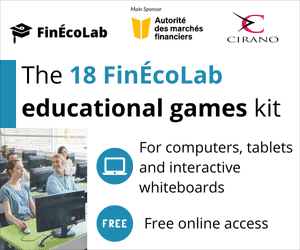Arne Andres has spent a lifetime confronting barriers to mobility.
Growing up in the Philippines, he was struck by a childhood bout of polio that left him in leg braces. Friends and family had to carry him in a little wooden box to get from the street to his classroom.
As a computer science instructor later in life, he struggled to climb the stairs in the building where he taught.

For his master's project, Arne Andres is working with a team developing an app using AI to help people with disabilities navigate mobility barriers in public spaces. (Photo: Geoff McMaster)
Accessibility was much better when he immigrated to Canada in 2001, but in a cruel stroke of bad luck, he was rear-ended in a car accident in 2015, leaving him severely disabled. He has been using a motorized wheelchair ever since.
One day while recovering in Edmonton's Glenrose Rehabilitation Hospital, Andres saw a flyer advertising an open house at the University of Alberta's Faculty of Rehabilitation Medicine. That's where he met the Click&Push Accessibility research team that would change his life.
Click&Push was developing a free, community-sourced navigation app called The Atlas to help users access public spaces more easily, using a crowd-sourced map to show them in real time the barriers they should avoid - such as elevators out of order, construction sites or other obstacles.
Much like a traffic report, the app would allow people to avoid unnecessary frustration by planning their day before leaving the house.
Andres immediately signed up to help test the app and ended up becoming a director at the startup. That led him into a second master's degree, this time a cross-disciplinary study in rehabilitation medicine and engineering that uses artificial intelligence - machine and deep learning - to identify and classify mobility barriers around the U of A's North Campus.
He also uses object detection and image segmentation technologies - as well as GPS tagging and cameras - all aimed at fostering a more inclusive higher education environment for people living with disabilities.
"The challenge is to ensure information on the app is up to date," says Martin Ferguson-Pell, Andres' co-supervisor along with Mustafa Gul and Maziar Jamshidi of the Department of Civil and Environmental Engineering.
"This way, scooter and bike riders, as well as wheelchair users, can upload images to The Atlas and seamlessly provide information about barriers that affect all wheeled mobility users."
For his pilot study, Andres has attached a GoPro camera to his wheelchair, collecting images and feeding them into his data set. The barriers on campus are many, cropping up as soon as he leaves his lab in the Edmonton Clinic Health Academy and attempts to board a train at the LRT station.
"I have these small wheels at the front of my wheelchair that are not power-driven, like casters. They always get caught between the train and the ramp, so I have to shout for people to push me."
Andres is tracking mostly physical barriers so far, but equally irksome are ableist attitudes and assumptions about accommodating disability, he says. Even his instructors are no exception, however well-meaning.
"In every course I have to explain the accommodations I need - they're not automatic. Instructors don't know what to do, like offering extensions for course work, or an adjustable desk in the classroom because the tables are too low."
Andres would like to continue his project at the doctoral level, widening his scope to include ableist assumptions. In the meantime, he hopes to make all of his findings available to campus planners, architects and builders, eventually scaling up his work to encompass Macewan University, NAIT and other Edmonton locations, as well as the University of Calgary.
"There will be a dashboard - a tool for stakeholders - with suggested modifications and retrofits, including how much accessibility is going to cost so construction companies can prioritize things. Because right now, there's nothing."
According to Ferguson-Pell, such information could also give companies an edge in bidding for projects.
"It's becoming more and more important in Canada that you address accessibility issues if you're running a business," he says. "It gives the company a competitive advantage if they can demonstrate they're working with an organization like Click&Push in Alberta."













